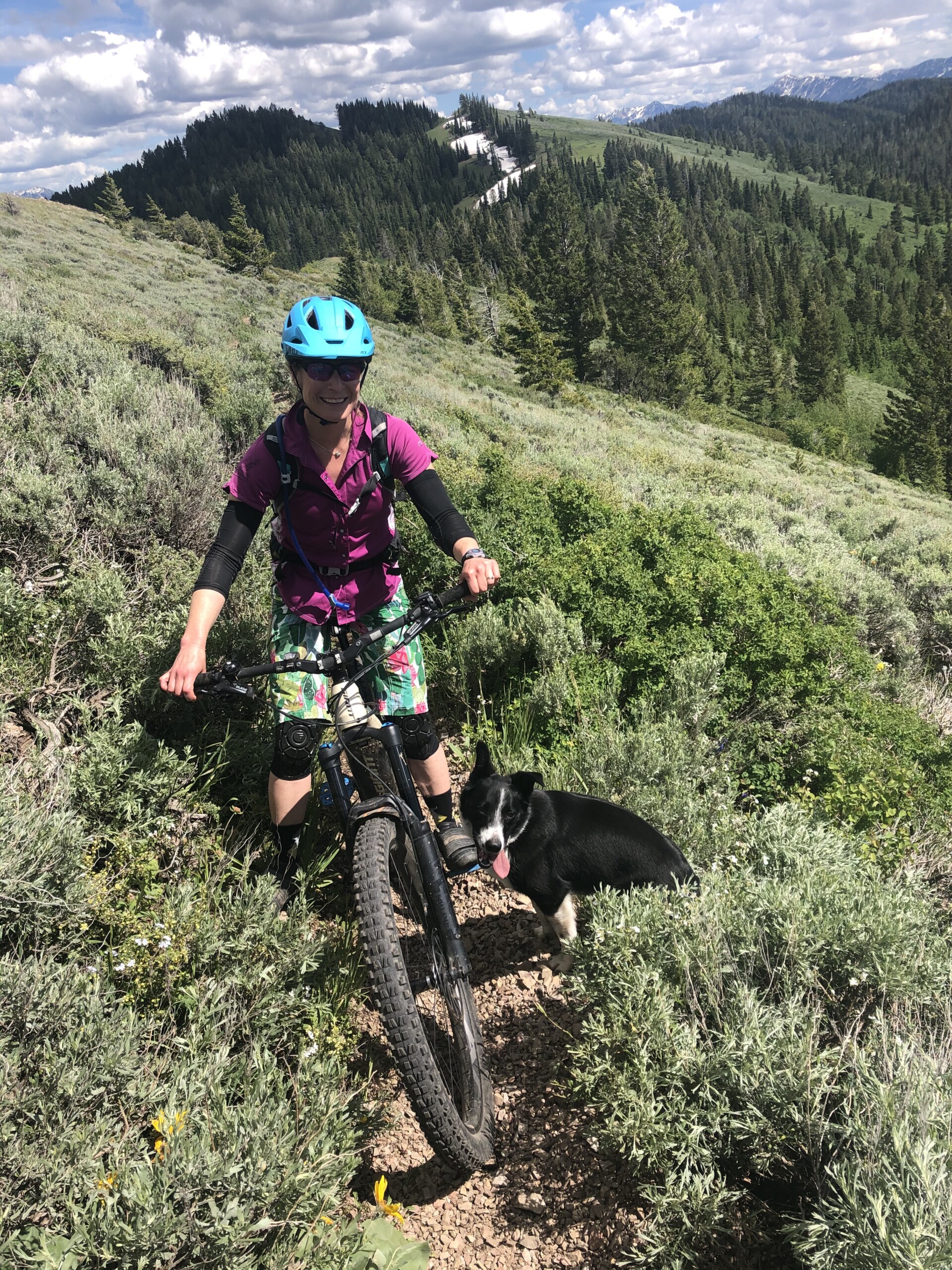By Molly Absolon — The first time I saw an electric bike — better known as an ebike — I was struggling up a hill. Suddenly, a silver-haired man came whizzing by in regular city clothes. I felt a wave of envy as he left me in the dust.
That was probably five years ago, and since then ebike use has exploded. In 2020, ebike sales in the United States for just the month of June totaled roughly $90 million, up 190 percent from the previous June.

It’s hard to remember, but regular mountain bikes didn’t become commercially available until the 1980s, and when the early adopters hit trails previously used only by hikers and horseback riders, conflicts happened fast.
People claimed the bikes increased erosion. They worried about collisions and scaring horses. They theorized that mountain bikes would frighten wildlife. Today, those same arguments are being used against electric mountain bikes.
Once again, the controversy seems to stem from the fear of change, perhaps some arrogance and maybe a little jealousy. After all, since I suffered to get to the top of the climb on my own power, shouldn’t you?
U.S. Agency positions: For now, the US Forest Service treats electric mountain bikes as motorized and limits their use to motorized trails. The Bureau of Land Management has opted to allow local land managers to make the call, but only after undergoing an environmental review of the trails in question.
In 2017, the International Mountain Bike Association, which had said that ebikes should be considered motorized vehicles, softened its stance. Instead, it proposed that local land managers and user groups should determine — on a case-by-case basis — whether to allow ebikes on naturally surfaced trails. Many members canceled their memberships. Some comments were harsh.
One wrote, “If you’re too old to still ride the trails you love, do as many beforehand, reminisce about the good old days and encourage the young. Don’t throw them and our public land under the bus.” That kind of attitude does not bode well for land managers to find an easy compromise.
So, what are the impacts of electric mountain bikes. Do they harm trails, or cause more accidents?
In 2015, the International Mountain Bike Association studied the environmental impacts of mountain bikes, both electric and self-propelled, and found no appreciable differences between the two in terms of soil displacement on trails. Overall, bike impacts were similar to the impacts of hikers.
Horses, motorcycles and off-road vehicles do much more damage to trails.
As for problems caused by speed, traffic studies show that accidents and their severity escalate as differences in speed increase. But do electrified bikes go that much faster than traditional bikes?
To find out, Tahoe National Forest measured the top speeds reached by intermediate and advanced riders using both kinds of bikes. Differences on the downhills were small. On uphills, traditional bikers averaged 5-8 mph, while electric mountain bikes traveled 8-13 mph. This was a difference, but not enough of a difference to cause more accidents, especially if bikers alert others to their presence and ride in control.
Rachel Fussell, program manager of the nonprofit PeopleForBikes, says that more than a battery boost, speed on trails reflects rider skill as well as trail design. She believes that all users observing proper trail etiquette would avert most potential conflicts.

Celeste Young has been a biker all her life and now coaches mountain biking. Her fleet of bicycles has recently grown to include an electric mountain bike.
“The most negative thing I’ve heard is, ‘Oh, you’re cheating,’” she says. “But it’s just another way to be out there. You get an extra boost going up these really hard trails, so it makes a challenging trail fun, rather than demoralizing.”
It’s a puzzling notion that someone accused her of cheating. It would be one thing if you secretly put a motor in your bike during a race, but when it’s an amateur rider going out for fun and exercise, how is having an electronic boost cheating?
The whole thing reminds me — a skier — of the controversy that erupted after snowboards appeared at ski resorts. They were new and fast, and their rhythm on the slope was different than the rhythm of people on skis.
We didn’t like them, and I doubt they liked us. But we’ve worked it out. Now, public land managers face the knotty problem of how much access to allow ebikes, and where, or whether to segregate them to their own trails. Welcome to the crowded West.
Molly Absolon is a contributor to Writers on the Range, writersontherange.org, an independent nonprofit dedicated to spurring discussion about Western issues. She lives in Victor, Idaho, and has worked as a wilderness educator, waiter, farmer and freelance journalist to support her outdoor recreation habit.








I have many concerns. One is the ease of changing the regulated speed of ebikes. Just look at YouTube ebike hacks, speedbox etc. We see in Sedona throttle ebikes where the casual street rider argues what’s the difference. Yes I know 98% of riders are legit and I see absolutely no problem with that. Land managers are going have to address many oddball situations.
Good Article, I think you hit a lot of the key points. I am….aging but have ridden the trails where I live for nearly 20 years. I see no reason to stop. I look at and explain the emtn bike as my range extender. I actually go up no faster than I did on my regular bike…but i can turn a 10 mile ride into a 20 and in some respects for the first time my enjoyment of that ride has increased significantly. Most of the people (90%) I see on the trail are curious or supportive. 1 in 10 are as use described arrogant, fear of change (more access) and maybe a little jealousy:-) There are still people that pass me and people I pass. So to me its really the same. I agree with the comment above that there are many oddball situations that are hard to deal with–the bike can go up a train fast, if wanted. However, with just following basic norms and etiquette there is absolutely no difference in my mind other I can no go farther and go to places that I could get to but would not want to climb out of. For me, it is a total winner and the change is inevitable.
From 5-8 mph to 8-13 not being much difference? Guess I’d have to disagree with that…it’s basically twice as fast. 12mph uphill on a trail is fast…like pro level fast.
I’m sure there’s trails where this would be no problem. But I think about already busy trails around Park City and picture groups of beginner/intermediate folks zooming up trails twice as fast as the non eBikes and don’t see great outcomes. And I see them getting further into more technical terrain where there skills don’t match the equipment.
Seems a good idea to help older folks get out. And certainly can work in some places. But also think there’s places where they would create a problem.
I’m not jealous of ebikes, but I don‘t like them. My feelings are more related to the shift in culture. Based on the ebike sales, they are sold to folks who would otherwise have shuttled uphill and want to put as little effort as possible in going uphill. In Boise, it has shifted the mtb culture to the point that mountain biking means only downhill riding with trails being designated downhill only. Riders here can’t even stop or stay on the trail when encountering an uphill rider, which is also part of the Strava effect rather than ebikes. The ship has sailed, and marketing dictates that ebikes are not going anywhere. So we’ll have to deal with it.
Relative to the average speed, why is that a consideration? If it is related to safety, then you can either think in terms of momentum, which will be at least twice as high from the extra speed and extra weight. Or you can consider energy, for which the speed is squared, so at least four times more energy involved in collisions. So, if you bring up speed differences, please work out the implications rather than just blowing the differences off. That said, anecdotes influence people more than physics.
I would have to agree with EB. It is a safety thing. There comes with the work of the good, old fashioned mtb, a level of respect for where you are. I have seen people who, because of a throttle, can get just about anywhere they want, but I don’t know that they belong there because they haven’t learned to respect the dangers that come with those places nor are they taking care of those places, again, due to a lack of earned respect. Also, some yahoo going uphill – again not sufficiently experienced because they throttle their way up instead of earning it – at 15mph is a serious danger to themselves and especially those who don’t have throttles. And finally, ‘NO MOTORIZED VEHICLES’ means no motorized vehicles. PERIOD!! The torque available to an Ebike will most certainly do more damage to trails, especially the steep uphills, than a traditionally powered bike.
Interesting comments so far. I understand the concerns but they are unfounded. My climbing times on my ebike are never in the top 10 on Strava compared to riders on normal bikes. On the descents i’m a little slower on my ebike.
This is like snowboarding all over again, oh my gosh, they’re on a different device doing basically the same thing.
Again, personal experience/anecdote is the only way most individuals seem to be capable of making a judgement. Without justification, people believe their experience to be representative. So be it. The bottom line is that there is too much money to be made from e-bikes, so there are here to stay.
Relative to skiing and snowboarding, I see the similarity in terms of cultural resistance, but both skiing and snowboarding require lifts and gravity. Perhaps the better analogy would be to compare skiing with or without mechanical lifts. With a lift, one does not need to earn the summit in order to descend. We all see how that evolved.
I had an interesting experience a couple days ago on the Morris Meadow connector trail from Bonneville up to the meadow. I was running up the trail and part way up I heard a bike behind me. I pulled over with my dog and allowed the rider to pass. The speed with which he accelerated past me made it clear he was on an e-bike. The encounter was polite and pleasant. On my way back down the trail, I encountered another e-bike, however this time it was technically an e-motorcycle. I asked the rider to take it easy, as the trail has a fair amount of foot traffic and he was moving at a quick clip. The encounter was VERY brief. However, as I continued down the trail I saw the results of his ride. Every curve and every little uphill ramp had skid marks where this rider with his high-torque e-bike hit the throttle. How will we manage the erosion and trail destruction from this kind of rider? How do you encourage appropriate behavior in a fragile environment?
I walked over to the supermarket in August of 2021 and there was an elderly lady locking her bike to the railing. I went up to her and said, “I notice your bike doesn’t have a motor”, and then, making a sweeping motion with her hands down the length of her body she replied, “I got a motor”. We chatted and it turns out she was 86 and had ridden to the store because she “was just looking for a reason to get out”. She’s my new hero.
So sorry, I’m just not terribly supportive of e-bikes. I know I’m going to come across as elitist and snotty, but we humans come equipped with our own motors and if there comes a time 10 years from now (when I’m in my late seventies) that I can’t turn over that gear to get up the canyon, I’ll get a smaller chain ring and get some more training miles in.
To me, e-bikes seem to be more suited as an automobile substitute for regular commuters. But for recreation and fitness, I’m highly skeptical. In any case, they aren’t going away anytime soon, alas. I do think that ultimately they will be supplanted by another fitness craze in the future, and knowing the tendencies of most Americans, it will likely be one that involves even less effort.
OMG! Have any of you had the opportunity to see the destruction on the Crest Trail due to non-motorized MTB’s overshooting corners? I’m sure there are other examples you know of similar overriding. Are these people skilled, or just “newbies” that don’t know how to ride? And do all the shuttle riders have the proper skills to ride that trail? Why isn’t anybody complaining about that?
And regarding “recreation and fitness”, I can get my HR just as high on my eMTB as my 24# pedal bike. If you’ve ever ridden an eBike you know how true that statement is!
I have to laugh about the weight (mass) issue. An eMTB weighs around 50# and an average rider may be 170# for a total weight of 220#. If this is too heavy, are you folks suggesting 200# riders should not be allowed on the trails? Come on!
I’ve been mountain biking since 1982 (I still have my 1983 rigid 3x Specialized Stump Jumper) and I’ve watched as bikes have gone from 3×7 to 1×13, manual brakes to discs, fixed seat posts to dropper posts, tubes to tubeless, no suspension to full suspension, steel/aluminum to carbon, handlebar shifters to electronic shifters, etc. This is called progress and no one seems to be objecting to these changes. I’m sure not.
What I’m sensing is the “ego” of the “purists” is causing their panties to get in a knot and they for some reason feel threatened. Relax. People on eMTB’s are not racing you! And Strava has an eBike category so you don’t have to worry about some eMTB taking your KOM’s. You’re still the top dog.
So, I say let’s all be “pure” and go back to single speeds, rigid (no suspension), rim brakes, steel frames, crappy saddles, etc., and just be cavemen & women again. Then we’ll all be even, lol.
Relax folks. Let’s all just have fun. And thank you Molly for a well-written article.
Comments are closed.